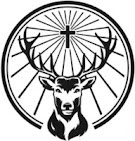The second was a smart-looking and ambitious Austrian deer:
The third was a rather dark and angry-looking German deer:
The Jägermeister deer has been around since 1935. When the Austrian and the German deer entered its territory, it felt challenged. Jägermeister wanted to show the newcomers who the pack leader was and went head-to-head with them. It took on the Austrian deer before Austrian courts and the German deer before a German court.
The battle with the Austrian deer
Background
Mast-Jägermeister SE (‘Jägermeister’) sells well-known herbal liqueur in the trade dress depicted below:
Jägermeister owns the following International Registrations designating the EU:
‘Jägermeister’ is one of the ‘brands of the century’ according to the German book ‘Deutsche Standards Marken des Jahrhunderts’ [‘German Standards Brands of the Century’]. In the annual ranking of the ‚Top 100 Premium Spirits Brands Worldwide‘ ‚Jägermeister‘ was ranked 10th in 2022. It is, according to the decision, a popular party drink enjoying a positive image, in particular because of the drink ‚Flying Hirsch‘ (known in English-speaking countries as ‚Jägerbomb‘).
The defendant is the Austrian supermarket chain SPAR Österreichische Warenhandels-AG (‘SPAR’). It sold herbal liqueur in the following trade dress in Austria:
The logo
Jägermeister filed for a preliminary injunction against SPAR’s herbal liqueur with an Austrian Court based on infringement of its trade mark with a reputation and unfair competition. The first instance court granted the injunction. The Vienna Court of Appeal dismissed SPAR’s appeal. SPAR appealed to the Austrian Supreme Court.
The Austrian Supreme Court’s decision
The Austrian Supreme Court dismissed the appeal (case 4 Ob 55/23a).
It was undisputed that Jägermeister’s trade marks enjoy a reputation in the EU in accordance with Art. 9(1)(c) EUTMR, especially among young party people. SPAR’s comic-like depiction of a dear was found to be particularly suitable to attract the same young public that Jägermeister’s beverage targets. Therefore, the contested trade dress was deemed to take unfair advantage of the reputation enjoyed by Jägermeister’s trade marks.
Affixing SPAR’s trade mark
The battle with the German deer
Background
Besides the trade marks depicted above, Jägermeister also owns German trade mark no. 302015043890, registered for ‘alcoholic beverages’ protecting the following sign:
SELVA NEGRA SPIRITS GmbH (‘Selva’) sells agave spirit, which bears the following label:
Selva also applied for registration of this label as EU trade mark no. 018417708 for ‘Agave spirits; Pre-mixed alcoholic beverages containing agave spirits’.
Jägermeister filed an opposition against Selva’s EU trade mark (which is still pending before EUIPO’s Opposition Division) and an infringement action before the District Court of Hamburg asserting that Selva’s label creates a likelihood of confusion with its earlier German trade mark, takes unfair advantage of its distinctiveness and reputation and infringes unfair competition law.
The District Court of Hamburg’s decision
The District Court rejected the action (case 315 O 274/21).
It found that Jägermeister’s German trade mark enjoys a reputation. Jägermeister submitted a survey showing that 63 % of the entire population and 78 % of consumers of liqueur recognized the following sign as a trade mark of Jägermeister:
While it is not identical to Jägermeister’s German trade mark depicted above, the judges considered them to be sufficiently similar to transfer the survey’s results to the German trade mark.
The court held that the signs are dissimilar. The relevant public would not establish a link between them. Both marks have in common a creature with antlers as the central figurative element. However, the representations of these creatures differ considerably. Jägermeister’s deer is much more naturalistic than Selva’s stylised mythical creature. The latter is, according to the judges, more reminiscent of a bull than a deer. The red headpiece and the letters “SELVA NEGRA” were also deemed significant differentiating elements.
The court also rejected unfair competition claims based on Jägermeister’s trade dress because the label shown below is not sufficiently similar to Selva’s label:
Comment
The moral of the story is twofold.
First: Producers of me-too-products beware! Taking a well-known figure from a popular product, changing it slightly and copying the colour code of the original goods is usually frowned upon by judges.
Second: There are limits to the scope of protection of well-known figurative trade marks. Courts appear to reject a similarity of signs when the style of the reputed mark is not imitated. A good example is the ‘jumping puma’ case. Although hardly anyone would recognise a puma in the following picture
the German Supreme Court (summarized here) agreed that this figurative mark was sufficiently similar to Puma’s well-known trade mark
However, does the depiction of a deer (even with bull-like features) head-on as a central element of a label really not evoke Jägermeister’s trade mark? This is a question that the Higher Regional Court of Hamburg will have to answer because Jägermeister appealed the first instance decision.
So instead of ending this post with ‘All’s well that ends well’, it is more appropriate to say
 Reviewed by Marcel Pemsel
on
Tuesday, August 15, 2023
Rating:
Reviewed by Marcel Pemsel
on
Tuesday, August 15, 2023
Rating:


















![[GuestPost] G1/24: Tuning in! A take on the state of proceedings before oral proceedings](https://blogger.googleusercontent.com/img/b/R29vZ2xl/AVvXsEjZhEivE5bp7QOwZsyZXAXbVNYSmLjUthkB2Q7fm1_dpB97u5lIQeyWT9ZadUTAH3Z-hXn13VpW4vBDRPx9emCnoDV6tbUTkyvfmqPv1nNInL8XMdrAtSZ2hcRQr2LjxKovC9wTk_XyZxQ0CtX1MUrO_Muz3OJ4ld8AftymsdUmKD7xNksYMwk6/s150/Picture%201.png)
![[Guest post] ‘Ghiblification’ and the Moral Wrongs of U.S. Copyright Law](https://blogger.googleusercontent.com/img/b/R29vZ2xl/AVvXsEhxl1BQBAW3Y-asjb1xXB9eA4DYy77fky6WgR-prC-_6DeBbDqOgCUDWyiz0Q3B23MWWAXnkbS2H2js7OUwA0JQXAHmsyVFgGIHeJz7zJ791vTzOD-4SJqWFIuywFXQyd3ahybbdZd4e8IEVfcNqctvyR8lumv_Gix6Tsw5cSvbHpTI1nwvztDuAQ/s150/IMG_2179.HEIC)

![[Guest book review] The Handbook of Fashion Law (with a discount code)](https://blogger.googleusercontent.com/img/b/R29vZ2xl/AVvXsEgB4h2AdqJKwq9O3Ft4Mb7C39tv_NeFpkzrOfvhIsuwAkM_ops2Hgj7fdwzq_TQsjQDvQrQa-yyC9Q9pNiugseXRlUaMdsr_cmYUbh9lH8HDECMCbsTuNboVgpafyEhkgDkVS6ruHkuz8Sx0QVGI_1S8R9kbsHdNIYrRjqhyphenhyphen010_txjJUYvlZOtWA/s150/Fashion%20Law%20Book%20Bicture.jpg)








Presumably the cross in the Jägermeister image alludes to the legend of St Hubert. Does its absence in the others not contribute to a lack of similarity?
ReplyDelete